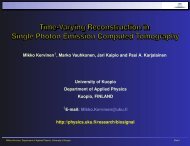Karjalainen, Pasi A. Regularization and Bayesian methods for ...
Karjalainen, Pasi A. Regularization and Bayesian methods for ...
Karjalainen, Pasi A. Regularization and Bayesian methods for ...
You also want an ePaper? Increase the reach of your titles
YUMPU automatically turns print PDFs into web optimized ePapers that Google loves.
28 2. Estimation theory<br />
where I =] − ɛ,ɛ[× · · · ×] − ɛ,ɛ[⊂ R p <strong>and</strong> ɛ is small. So this cost gives zero penalty<br />
if all components of the estimation error are small <strong>and</strong> a unit penalty if any of the<br />
components is larger than ɛ. When C UC (θ, ˆθ) is substituted into the equation of<br />
conditional Bayes cost (2.41) we obtain<br />
∫<br />
B UC (ˆθ|z) = p(θ|z)dθ (2.77)<br />
˜θ∈I<br />
∫<br />
= 1 − p(θ|z)dθ (2.78)<br />
where I states <strong>for</strong> the complement of I, <strong>and</strong> using the mean value theorem <strong>for</strong><br />
integrals [5] there is a value, say ˆθ, in I <strong>for</strong> which<br />
˜θ∈I<br />
B UC (ˆθ|z) = 1 − (2ɛ) p p(ˆθ|z) (2.79)<br />
To minimize B UC (ˆθ|z) we must maximize p(ˆθ|z) so ˆθ UC can be defined by<br />
p(ˆθ UC |z) ≥ p(ˆθ|z) (2.80)<br />
<strong>for</strong> all ˆθ. Since ˆθ UC maximizes the posterior density of θ given the observations z,<br />
ˆθ UC is also called the maximum a posteriori estimate ˆθ MAP .<br />
ˆθ UC is the mode of density p(θ|z) <strong>and</strong> yet another name <strong>for</strong> the estimator<br />
is the conditional mode estimator. It can be shown, that if we assume that the<br />
prior distribution of θ is uni<strong>for</strong>m in a region containing the maximum likelihood<br />
estimate, then the maximum likelihood estimate is identical to maximum a posteriori<br />
estimate, that is ˆθ ML = ˆθ MAP [133]. Clearly ˆθ MAP = ˆθ MS if the mode of the<br />
density p(θ|z) equals to the mean η θ|z . This is the case when p(θ|z) is symmetric<br />
<strong>and</strong> unimodal.<br />
2.8 Linear minimum mean square estimator<br />
In this section we restrict the <strong>for</strong>m of the estimator to be a linear function of<br />
data <strong>and</strong> derive the optimum estimator with this structural constraint. If certain<br />
conditions <strong>for</strong> densities p(θ) <strong>and</strong> p(z) are fulfilled, this optimal linear estimator<br />
turns out to be generally optimal.<br />
Let the estimator be constrained to be a linear function of the data<br />
ˆθ = Kz (2.81)<br />
Let θ <strong>and</strong> z be r<strong>and</strong>om vectors with zero means <strong>and</strong> known covariances. No other<br />
assumptions are made about the joint distribution of the parameters <strong>and</strong> data.<br />
We derive the estimator that is of the <strong>for</strong>m (2.81) <strong>and</strong> minimizes the mean square<br />
Bayes cost B MS (ˆθ). We first note that<br />
}<br />
B MS (ˆθ) = E<br />
{˜θT ˜θ<br />
= E<br />
{<br />
(θ − ˆθ) T (θ − ˆθ)<br />
}<br />
(2.82)<br />
(2.83)





